KSEEB Solutions For Class 8 Biology Chapter 8 Health And Hygiene First Aid
The term health broadly means that the body is fit and has a general well-being.
According to World Health Organization, (WHO) definition of health is as follows: “Health is a state of complete physical, mental and social well-being and not merely an absence of disease or infirmity.”
Any condition that interferes with normal body functions due to some reason is called disease. Diseases can either be caused by various microorganisms or due to different biological or environmental factors.
Diseases are generally classified into two types—Communicable and non-communicable diseases.
Communicable Diseases
Communicable diseases are diseases that spread from a diseased person to a healthy person. They are caused by some pathogens or germs such as viruses, bacteria, fungi, protozoa and worms. Germs spread the disease through different modes such as air, water, food and organisms known as vectors.
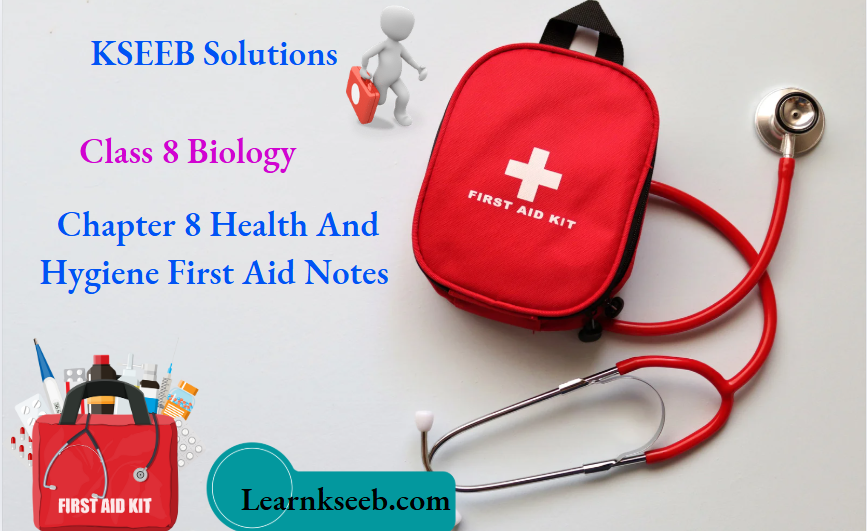
KSEEB Class 8 Biology Chapter 8 Health And Hygiene First Aid Solutions Pdf
Direct Contact
Diseases like the common cold, chicken pox, measles, etc., spread through direct contact with the infected person.
Water Bone And Food-Borne Diseases
Diseases like typhoid, diarrhea, etc., are caused by eating contaminated food or drinking dirt)’ water. The reasons forthe contamination of food and water are:
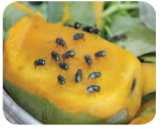
• Improper handling of food and water such as keeping food in unclean area, eating food with dirty hands, etc.
• Eating food products from diseased animals. For example, milk, cheese, eggs, and meat.
• Many insects like cockroaches and houseflies carry germs on their legs that they pick up from dirty water in drains and sewers. These insects when sit on uncovered food contaminate it
Air-Borne Diseases
Diseases like cough spread through germs present in the air due to sneezing or coughing by an infected person.
Class 8 Biology KSEEB Health And Hygiene First Aid notes
Vector Borne Diseases
Diseases like malaria, dengue, etc., spread via insects. These insects curry germs that get transmitted from infected person to healthy person. Such insects are called as vector. For example, mosquitoes spread malaria as they are the carriers of protozoan Plasmodium.
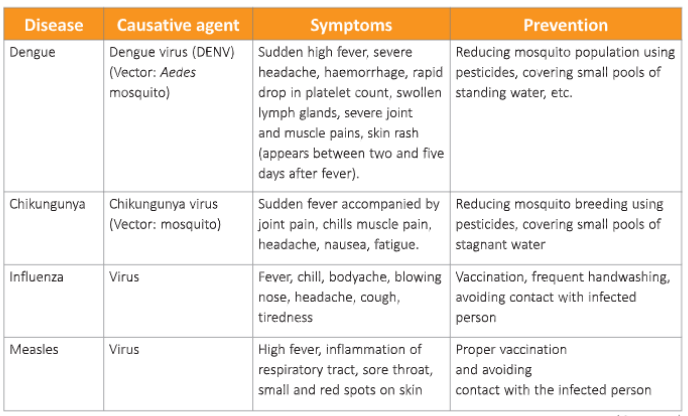
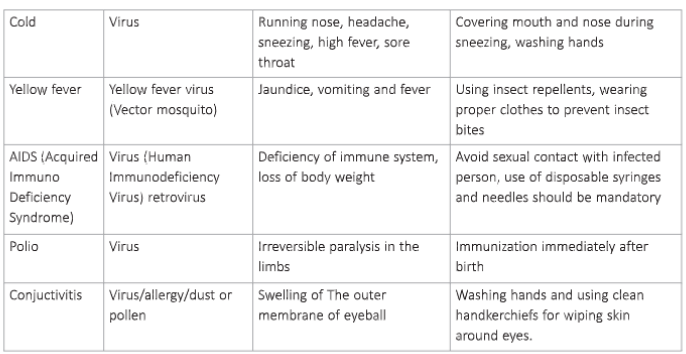
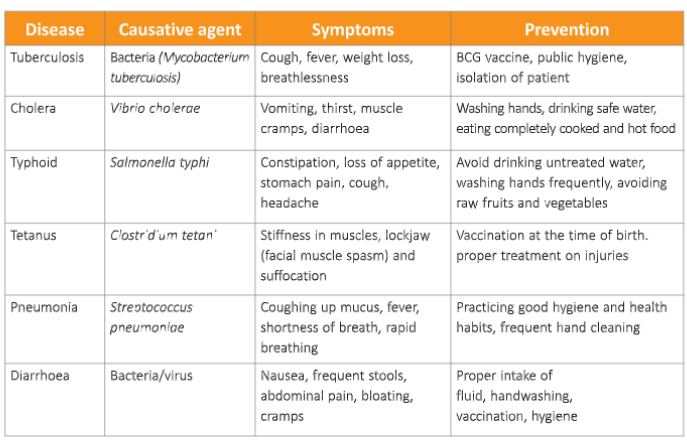
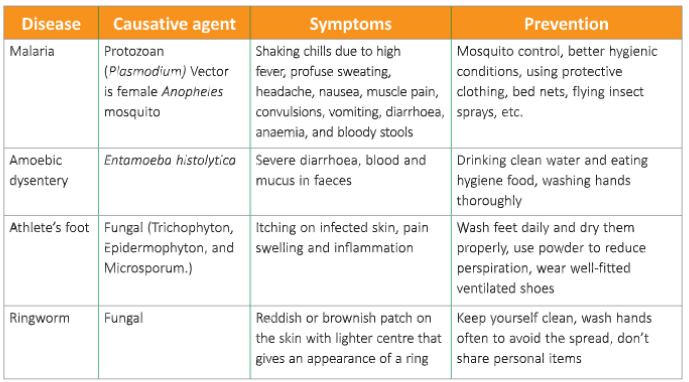
SSLC Class 8 Biology Health And Hygiene First Aid Question And Answers
Non-Communicable Diseases
Non-communicable diseases are diseases that cannot be spread from one person to another. They are not caused by any organism. Main causes of non-communicable diseases are either deficiency of one or more nutrients or malfunctioning of any organ. Some of the non- communicable diseases are listed under the following heading:
Deficiency Diseases
Deficiency diseases are caused by insufficient intake or total lack of important nutrients that are essential for the growth and maintenance of the body. Some well-known examples of deficiency diseases are Kwashiorkor and Marasmus.
Metabolic Disorders
A metabolic disorder develops when some organ such as liver, pancreas, kidneys, heart, etc., do not function normally. Diabetes, heart disorders and thyroid disorder are some examples of metabolic disorders.
Genetic Disorder
A genetic disorder is a condition caused by abnormalities in genes or chromosomes. These diseases are present in the cells of the body since conception. Examples of genetic disorders are colour blindness and haemophillia.
Prevention Of Diseases
Some measures to prevent diseases and remain healthy are given here:
- Articles of daily use such as clothing, handkerchief, towel should be cleaned or disinfected regularly.
- Be careful always regarding personal cleanliness by taking regular bath with a good soap or shampoo.
- Food items exposed to flies should not be used.
- Drinking water should not be left uncovered.
- Teeth should be brushed after every meal.
- Before every meal, hands should be washed properly with germicidal soap.
- Utensils, clothing and food articles of patients should be kept isolated.
- Keep yuur bathrooms, toilets clean and cover dustbins properly.
- Never allow water to get collected in pools and ditches around your house. Regularly change water from coolers because this promotes breeding of mosquitoes.
- Spraying of disinfectants and insecticides should be done in house time to time.
- In case someone is ill, proper medication should be given to that person for fast recovery.
KSEEB Class 8 Biology Health And Hygiene First Aid Textbook Solutions
Immunity
Immunity refers to body’s defence against diseases. The immune system is the body’s defense against infectious organisms and other invaders. Through a series of steps called the immune response, the immune system attacks organisms and substances that invade body systems and cause disease. Disease causing pathogenic microorganisms enter our body through inspiration, food and water. Our body has some natural mechanisms to stop the foreign body.
For example, hair and mucous membrane of nasal chamber prevent the entry of germs, dust and carbon particles. Tears contain antibacterial substances which kills the bacteria. The microorganisms entering in the stomach arc killed by hydrochloric acid present in gastric secretion. When the infection enters in the blood, white blood corpuscles fight against this infection. The immune system makes antibodies which react with the germs to destroy them and give protection to body against diseases.
After recovering from the diseases, these antibodies stay in the blood for the prevention of recurrence of the disease. There are two types of immunity namely innate and acquired immunity. Innate means inborn immunity. In inborn immunity, certain antibodies come from the parents against the antigens which cause the diseases. The pathogens of these diseases do not flourish in the body of the animals and thus its body is protected from the disease.
For example, human beings have inborn immunity against distemper, a fatal viral disease of dogs even if exposed to its infection. Acquired means the immunity which a person attains after birth when it is infected by a disease causing germ. It is also called life time immunity. Acquired immunity is achieved when antibodies are produced in the blood in the response to the antigens. These antibodies provide immediate protection against further infection.
Vaccination
There are various ways in which spread of the diseases can be prevented. For some diseases, vaccinations arc available that help the body in fighting against the germs. Most of the vaccines are given in the form of injection or orally to the toddlers between the age of two months to six years. Some of these vaccines do not provide immunity for lifelong and are therefore repeated in a few years. These doses are termed as booster doses.
Diphtheria, pertussis, tetanus, tuberculosis, polio, measles and number of other diseases can be controlled by vaccination. The vaccine triggers the immune system inside the body. As a result, antibodies arc produced against the specific disease-causing microbes. The antibodies stay in the blood to fight against a possible attack of pathogen.
Immunisation
Immunisation is the process by which the body becomes immune or resistant to certain diseases. The immunity can be natural or acquired. Usually, people consider that vaccination and immunisation are same, but actually they are different. Immunisation is the ability, that develops after vaccination, in a human body to fight diseases. Whereas, vaccination is the administration of the vaccines through injections.
Unhealthy Habits
It has been observed that often people try smoking or consuming alcohol and other drugs while having fun with friends, but later on it becomes a habit for them. All these as written on their labels also are injurious to health.
Tobacco Addiction
People use tobacco in different forms. Some people chew it others use it in betel leaves known as paan. It is also used as smoke in the form of cigarettes, beedis and, hubble bubble (hookah). Chewing of tobacco can lead to oral and throat cancer. Smoking tobacco also results in high blood pressure, respiratory problems and in some cases lung cancer also.
Karnataka SSLC Class 8 Biology Chapter 8 Solutions In English
Alcohol Addiction
Alcohol addiction, also known as alcoholism, is a disease that affects people of all walks of life. Alcoholism is the inability to control drinking due to both physical and emotional dependence on alcohoL Some common alcoholic products are
generally consumed by a large group of population. Alcohol retards mental activities and affects the nervous system. People driving under the influence of alcohol have more chances of accident because their judgement becomes poor on road due to less coordination among the body systems.
Drug Addiction
A medicine is a drug which is taken by the people for the treatment and cure of diseases. All medicines are drugs as they cure us against infections. There are many drugs which are not medicines and are very dangerous for our health. These drugs are heroin, smack, marijuana, cocaine and opium.
Consumption of any one of these drugs can lead to addiction showing nausea, nervousness and pain in stomach as symptoms. Apart from health issues, these drugs also cause social and economical problems to their addicts.
Health And Hygiene First Aid Class 8 Biology KSEEB Important Questions
First Aid
First aid is the provision of initial care for an illness or injury. It is usually performed by a non-expert or untrained person on a sick or injured person until the required medical treatment or aid arrives. It generally consists of a series of simple and potentially lifesaving techniques that can be performed with minimal equipment.
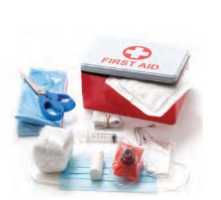
We should always keep a first aid box at home and school at easy reach so that it can be used whenever a need arises. A first aid box contains necessary medical items such as antiseptic lotion, antiseptic cream, band-aids, a pair of scissors, crepe bandage, some painkillers, etc
First Aid For Cuts
It’s natural to get cut anywhere. If the cut is severe get to a hospital right away or if you must wait for an ambulance, begin following treatment:
- Rinse the cut or wound with water.
- If die wound is small, dien apply some direct pressure to the wound by hand. This will help stop bleeding.
- Raise the injured part to reduce blood flow to the wound.
- Place the person at rest and quickly cover the wound with dressings, and continue keeping the pressure with bandage or clean cloth
- Before applying a bandage to the wound, check for circulation below the injury and then, bandage the injury.
- After bandaging, check circulation below the injury again lo ensure that blood flow has not been restricted by bandaging. If necessary, loosen the bandage enough to improve circulation.
- If the dressings has got blood on it, don’t try to remove and continue the pressure. Removing the dressings frequently may disturb blood clots and expose the wound to further infection.
- For severe bleeding, always seek medical attention.
Health And Hygiene First Aid Class 8 Biology Summary And Explanation KSEEB
First Aid For Burns
If your clothes or your friend’s clothes catches fire stay absolutely still and follow the given instructions.
- Do not try to run. Flames need oxygen to keep them burning.
- Rolling on the ground will slop them from getting any oxygen and help put them out. Wrap something like a woollen blanket around die person to smoother die flames.
- Take off any clothes or jewellery around the burned area of die body, before it swells.
- Use cold running water for 20 minutes to cool the burn but do not use ice.
- Do not break blisters. Exposed blisters can get infectious or septic. If blisters break, gently clean the area with mild soap and water, apply an andbiotic ointment.
- Keep the person warm with extra clothes on the unhurt parts of the body.
- See a doctor if the bum is severe.
First Aid For Fractures
A fracture is a broken bone. If after an accident, fracture is suspected, then don’t move the person unless it is necessary, to avoid further injury. Take following actions immediately while waiting for medical help:
- Apply pressure to the wound to stop any bleeding with a sterile bandage or a clean piece of cloth.
- Don’t try to realign the bone or push a bone that’s sticking out back in. Immobilise the area completely. Padding the area can help relieve the pain.
- Apply ice packs to limit swelling and help relieve pain.
First Aid For Poisoning
Poisoning causes injury or death due to swallowing, inhaling, touching or injecting various drugs, chemicals, venoms or gases.
If the person is drowsy, immediately lake medical help.
- If the person has swallowed poison, try to take out all of it, if any poisonous substance is still in the person’s mouth.
- If the person has touched any harmful poison on the skin. Remove it using gloves and rinse the skin for 15 to 20 minutes.
- If poison has gone in the eye, gently flush the eye with cool or lukewarm water.
- If the person has accidently inhaled poison or gas, take the person into open area with fresh air as soon as possible.
- If the person vomits, turn his or her head to the side to prevent choking. Always consult doctor for medical assistance
KSEEB Class 8 Biology Health And Hygiene First Aid Solved Exercises
First Aid For Object In Eye
Sometimes, foreign particles enter our eye. These may cause damage to the eye if proper care is not taken. If something falls in the eyes accidentally, wash the eyes thoroughly with water. Consult a doctor, if irritation persists and put prescribed eye drops.
First Aid For Stings
Bug bites and stings generally cause uneasiness and extreme pain. However at times, they can lead to infection that necessitates proper treatment.
- Try to remove the stringer as soon as possible.
- Wash the area carefully with soap and water.
- Rub on with an ice pack wrapped in a cloth or a cold, wet towel for few minutes.
- Seek medical care if you notice a large skin rash or swelling around the sting site or if swelling or pain persists for more than three days.
- Get medical help right away if you notice any of the following signs: wheezing or difficulty in breathing, tightness in throat or chest, swelling of the lips, longue or face, dizziness and nausea or vomiting.
Explanation Of Health And Hygiene in KSEEB Class 8 Biology
First Aid For Animal Bites
Animal bites and scratches that break the skin can sometimes cause infection. Animal bites of dogs, rats, bats, raccoons and foxes can lead to rabies, a life-threatening disease. Following instructions should be followed.
- Let the wound bleed, and then wash the wound in running water for three to five minutes to remove the animal saliva.
- Wash the wound properly with soap and water.
- If the bleeding has stopped, apply antibiotic ointment.
- Consult a doctor immediately.
First Aid For Snake Bites
If you are bitten by a venomous snake, immediately call ambulance, especially if the area changes colour, begins to swell or is painful. Many hospitals stock antivenom drugs. In case of snake bite, follow these instructions:
- Remain calm and move beyond the snakes striking distance. All snakes are not poisonous.
- Remove jewellery and tight clothing before the area with bite starts to swell.
- Wrap a bandage or cloth 2-4 inches above the area which has been bitten.
- Get a doctor s assistance immediately.
First Aid For Unconsciousness
Unconsciousness is a state where a person suddenly docs not respond to any stimuli. It is related to fainting and can occur for short or longer periods of time. Main causes of unconsciousness include severe bleeding, a car accident, a blow on chest or head, etc.
Temporary unconsciousness is seen in people in cases such as low blood sugar, dehydration, straining, etc.
If someone is unconscious, follow these simple steps to make that person conscious:
- Lay the person on his/her back.
- Loosen the clothing of the unconscious person such as any restrictive clothing, belts, etc.
- Check the person’s airway for any obstruction.
- Check again to sec if the person is breathing, coughing or moving. If these signs are absent, perform CPR (Cardiopulmonary resuscitation) or mouth to mouth breathing
- Kneel to the level of the unconscious person’s neck or shoulder.
- Place the heel of your hand at the centre of the person’s chest. Place your other hand directly on the first hand and interlace your fingers.
- Push straight down on the persons chest keeping your elbows straight and moving your shoulders above your hands. These are called chest compressions.
- Repeat this procedure for about 100 times per minute.
You can also give the person mouth to mouth breathing or rescue breathing in between. Continue the procedure mentioned above until medical help arrives.
Class 8 Biology Health And Hygiene First Aid Notes Karnataka Board
Keywords
- Non-communicable disease: Diseases that are not passed-on from one person to another
- Communicable disease: Diseases that are passed-on from one person to another
- First aid: The provision of an initial care for an illness or injury that can save a life
- Genetic disorder: A condition caused by abnormalites in genes or chromosomes
- Hygiene: The maintenance of good health and cleanliness
- Kwashiorkor: A disease in children caused due to deficiency of protein intake
- Marasmus: A disease in children due to deficiency of protein and carbohydrate in diet
- Pathogen: Germs that cause diseases
- Vaccination: Doses given artificially to increase the immunity of body against a particular disease
- First aid: The immediate help given in case of an accident
Summary
- Diseases can be classified into two main types—communicable diseases and non-communicable diseases.
- Diseases can be caused by pathogens such as viruses, bacteria, fungi, protozoa mites and worms.
- Diseases can spread through contact, air, vectors, infected food and water, or bites of animals.
- Diabetes is caused due to the malfunctioning of pancreas.
- Vectors are the organisms which carry the disease causing pathogens from the source of infection to the healthy person without getting affected.
- Hemophilia is a genetic disorder disease which is caused by body’s inability to control blood clotting or coagulation.
- Kwashiorkor and marasmus are caused due to the deficiency of proteins and carbohydrates in the diet.
- One must avoid bad habits such as addiction to tobacco, smoking, and taking alcohol and drugs. These habits have harmful effects on our health.
- The immediate help given to a victim of an accident, burn, bite, or cuts is called first aid.

